The combination of creative chemistry, personality traits and heritage exhibited by the stars of “Key & Peele,” Keegan-Michael Key and Jordan Peele, has resulted in a perfect storm of comedic output over three seasons. As likely to send up “Les Miserables” with ornate period costuming and Broadway-quality singing as they are to skewer race relations and American politics with skits like “Obama’s Anger Translator,” the duo has captured the hearts – and laughs – of a vast, possibly unprecedented cross-section of viewership.
“What’s amazing about our show is that 57-year-old white men have come up and said how much they enjoy the show because their son turned them on to it,” Keegan-Michael Key told comedian Patton Oswalt in an on-stage conversation last night at Beverly Hills’ Paley Center. “Their son is probably 17 and he lives in an enormously different world than [those older men do].”
The discussion with Oswalt also included Jordan Peele. A self-proclaimed super-fan of the show, Oswalt seemed somewhat giddy to be talking to the duo in a public forum, and spent much of the time mulling over specific skits that have struck a chord with him and with millions of viewers on-air and online. But along the way, a thread did manage to emerge regarding what “makes” a successful “Key & Peele” sketch, or, as Peele put it, does “something only Keegan and I would do.”
“Our show is a very in-between show for a very in-between time,” Peele told Oswalt, “and we find ourselves juggling sentiments that existed 50 years ago… there are things that just haven’t changed. On one hand we have to address those things… being a mixed race ourselves we find ourselves taking advantage of being able to go to all these different places.”
The duo implied that issues of race, sexism and other hot-button topics often woven into their work are framing devices for the comedy itself. The enduring power of their sketches come not from topical or issue-driven premises, but from universal concerns such as emotion and well-developed characters.
“If there is a Key and Peele template it’s put human stories in a new or different frame,” said Key.
Citing a “Key & Peele” sketch in which the band LMFAO becomes trapped in a party that literally never ends, Oswalt suggested the duo’s comedy has a darkness to it that can border on the scary. “That sketch cracked me up and it gave me the creeps,” he said.
“We love to infuse other emotions besides fun and comedy,” Peele replied.
The duo also discussed the show’s unique production schedule, which entails writing and shooting all the sketches at once, several months out from the given season’s air dates. Not being able to implement topical or current events-driven humor “was a real challenge at first in making the show one you have to watch,” said Peele, “especially with shows like “SNL” that are event television.” But in the end, Key and Peele realized the schedule was a blessing in disguise as it forced them to create comedy that works outside of a given time frame. “What began as a kind of curse became a blessing for the legacy of the show,” said Peel. “Our sketches are evergreen.”
“Because it had to be evergreen we stumbled into this human condition thing,” added Key.
As the event drew to a close, Oswalt took questions from the audience. One fan asked if the duo feels an increased burden having ascended to a rarified position in the pantheon of comedic greats.
Entering their fourth season now and stronger than ever, Peele said if anything he felt “almost a weight off our shoulders… We’ve always felt the support from the network, but now our mind isn’t so much on ‘will we get picked up next year?’ but now, “let’s have some fun!’”
Tags:













































__twocolumncontent.jpg)











